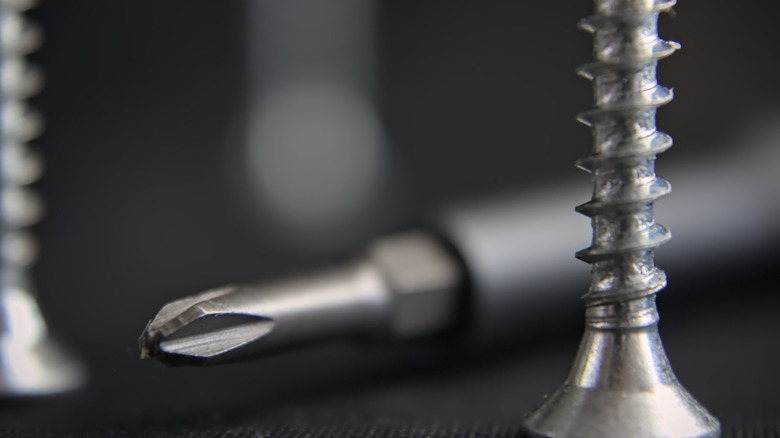How Did The Phillips Head Screwdriver Get Its Name?
While there may be no practical way to qualify such a claim, one could likely still argue that the Phillips head screwdriver ranks among the most frequently used hand tools in modern history. And if you're looking to assemble a tool kit for your home, a Phillips head screwdriver is about as essential a tool as a hammer or a tape measure.
It is not the end-all-be-all screwdriver you'll need, of course, as there are roughly a dozen different screw heads in circulation today. Despite the screw head disparity, the Phillips head continues to be one of the go-to screws for builders and manufacturers. That fact is all the more fascinating because, currently, the Phillips head screw and screwdriver have only been around for a little over 90 years. The design was first patented in the early 1930s, though it was not the first patent filed displaying the so-called "cruciform orifice," with English inventor John Frearson displaying a similar design several decades prior.
Nonetheless, the screw and driver patented in 1933 would become the one that not only revolutionized industrial work but became a staple in virtually every home toolbox for decades to come. As it was, the patent was awarded to a Portland, Oregon-based businessman by the name of Henry F. Phillips. And yes, Phillips ultimately decided to name the game-changing screwdriver after himself. That decision was pretty questionable, though, as Phillips is not credited as the screwdriver's inventor.
What to know about the origins of the Phillips Head Screwdriver
It was actually another Oregonian named John P. Thompson who created the revolutionary screw head and driver that Henry F. Phillips named after himself. While much is known about Phillips, the same is not true of Thompson. However, we do know that he moved to the Portland, Oregon area in the early 1920s and essentially worked as a laborer for much of his time there. According to records, Thompson died in Portland in 1940 and had been employed as an auto mechanic when he invented his screw and driver set.
It was actually Thompson who filed the paperwork for the screwdriver with the U.S. Patents Office in 1932. But when the patents were granted a year later, they were assigned "By Direct and Mesne Assignments" to one Henry F. Phillips, even as Thompson was still credited as the inventor. It's not entirely clear how he knew Thompson or how he acquired the rights to the man's screwdriver concept, though it's believed that Thompson was unable to market and manufacture the screwdriver on his own and found a willing buyer in Phillips, who was then the managing director of the Oregon Copper Company.
After securing his patents and naming the screwdriver, Phillips promptly founded the Phillips Screw Company and began refining the design. By 1936, he was satisfied with the design and had filed more patents as potential upgrades. A year later, General Motors became Phillips' first industrial customer, utilizing the screw to build Cadillacs.
It was not all smooth sailing for the Phillips Screw Company
That might seem a fitting point in the story to add, "and the rest, they say, is history." but even as the Phillips Screw Company's industrial foothold helped drive revenue past $1.3 million in royalties alone in 1940, it was not all smooth sailing for Henry F. Phillips and his screwdriver endeavor. In fact, things quickly got hairy for Phillips and company, as the outbreak of World War II changed how he could do business.
Sure, the U.S. war effort provided a legit boom for his screws, but that boom came at the cost of limiting the foreign bodies that the Phillips Screw Company was legally permitted to do business with. More specifically, it limited the company's dealings with Japanese manufacturers, with whom Phillips had brokered several lucrative licensing deals. Phillips would ultimately retire in 1945, and in 1947 his company would find itself facing its biggest test to date via a suit filed by none other than the United States Government.
The crux of that suit alleged that the Phillips Screw Company had engaged in anti-competitive practices. Among the filings, the government charged the company and 17 manufacturers with patent pooling, price fixing, the suppression if competing technologies, and even cartel practices. The case concluded in 1949, with the ruling resulting in the dissolution of the patent pool. By 1966, the patents had expired entirely, making it easy for virtually all the best hand tool manufacturers to use Phillips head design. Even still, the Phillips Screw Company soldiers on and is today operating out of Massachusetts.


